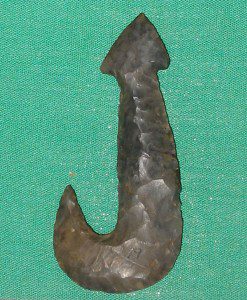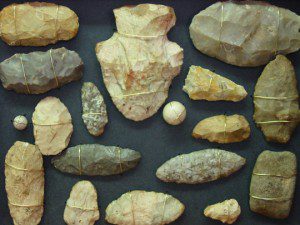The Karankawa lived along the Texas Coast from Galveston Island to south of Corpus Christi and as far inland as Eagle Lake in present day Colorado County. The name Karankawa meant “dog lovers” in their own language.
Explorers found the natives daunting because of their height and appearance. The male Karankawa’s were said to be very tall. According to Joutel, who kept a journal of the La Salle  expedition, the men wore breechcloths. Some of the men wore deerskin bracelets, small shells, glass beads, or small discs of metal around their necks. Naked for the most part and covered in alligator or bear grease to ward off mosquitoes, they wore tattoos on their bodies. They pierced the nipples of each breast and the lower lip with small pieces of cane. The Karankawa’s ferocious appearance and smell, along with the fact there were rumors they were cannibalistic put fear and terror into all who visited them. This fact has never been verified.
expedition, the men wore breechcloths. Some of the men wore deerskin bracelets, small shells, glass beads, or small discs of metal around their necks. Naked for the most part and covered in alligator or bear grease to ward off mosquitoes, they wore tattoos on their bodies. They pierced the nipples of each breast and the lower lip with small pieces of cane. The Karankawa’s ferocious appearance and smell, along with the fact there were rumors they were cannibalistic put fear and terror into all who visited them. This fact has never been verified.
The female Karankawa were of normal height and Stephen F. Austin described some of them as being handsome. They adorned themselves with tattoos as well as the men and wore skins around their waist to their knees. The children of the tribes wore nothing. Married women painted the entire body; unmarried women wore simple stripe tattoos from forehead to chin.
The Karankawa used bows and arrow points for hunting and fighting. The bows were said to be almost as tall as their owners and the arrow shafts were two and one-half to three feet in length. They had amazing skill with them. Arrows and bows were even used when fishing. They were seasonal hunters and gatherers. Fish, shellfish, oysters and turtles were some of the staples of the Karankawa diet, but a wide variety of animals and plants contributed to their sustenance. Of the larger mammals, they hunted bison, deer, javelina, antelope, bear and alligators.
Some of the non-game foods they used were the prickly pear (fruits and pads), dewberries, cattails, husk tomatoes, wolf berries, nuts and Mustang grapes. Prickly ash was used as a toothache remedy and a small growth on the white oak was used to tan hides. The leaves of the Yaupon holly, not the berries which are poisonous, were used in their pipes and as a tea for the Mitole dance.
The Mitole was a ceremony performed to celebrate a great victory. It lasted three days and three nights. It was at this ceremony that they earned the title of cannibal. In an effort to prevent the enemy warrior from having a second or third life they would cut pieces from the live victim, cook them and eat them before finally killing him. Eating the enemy’s flesh was an ultimate act of revenge. Cannibalism was practiced as a ritual, not as a dietary preference.
 The Karankawa used a canoe, known as a dugout, to travel the waterways. They took a twenty-foot long tree trunk, and used hot coals and an adze to hollow it. They would then propel themselves by hand or by the use of a crude sail constructed from animal hides. They were fit only to travel in the shallow waters of the inlets and lagoons in the area. They could not be used for travel in the rougher waters.
The Karankawa used a canoe, known as a dugout, to travel the waterways. They took a twenty-foot long tree trunk, and used hot coals and an adze to hollow it. They would then propel themselves by hand or by the use of a crude sail constructed from animal hides. They were fit only to travel in the shallow waters of the inlets and lagoons in the area. They could not be used for travel in the rougher waters.
Their homes were simple structures made from willow sticks and hides, grasses, palm fronds or leafed branches. The structure was called a ba-ak. They were nomadic and rarely took their homes with them. They made simple crafts, such as flutes and rattles. Their pottery was thin and generally coated with asphaltum, the natural tar that washed ashore on the beaches. They used the same material to line the insides of baskets to make them waterproof.
They disappeared sometime in the early 1800s. In 1840 only about 100 Karankawa were left. By the year 1860, on the eve of the American Civil War, the Karankawa had completely disappeared. The only evidence that they ever existed comes from early accounts of explorers and settlers, plus the artifacts that have been excavated at their campsites.